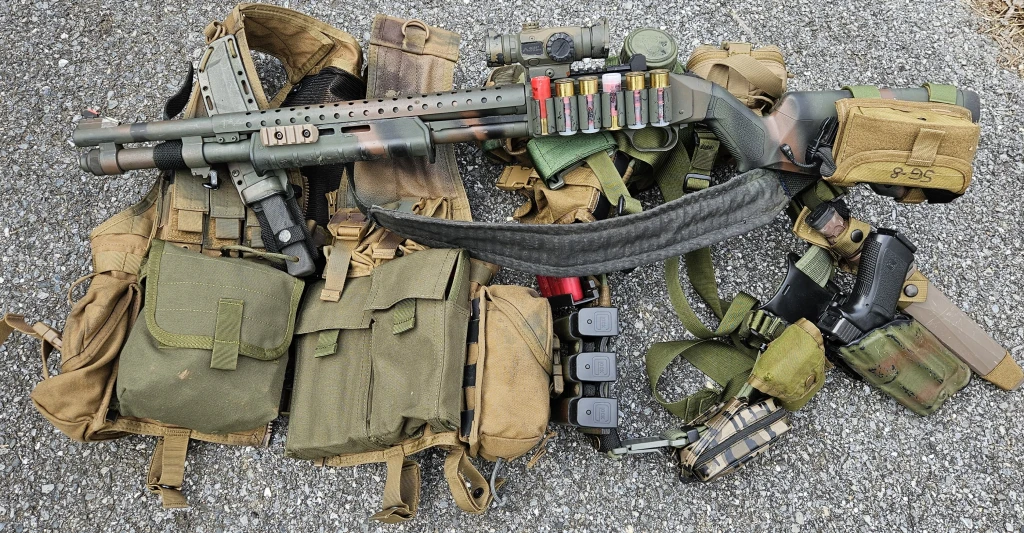
I’ve been hearing a lot recently about using shotguns for drone defense, so I thought I’d give my personal opinion and experiences, concerning shotguns in general, riotguns specifically (especially for flying targets), and the carriage of ammo for those shotguns in the field. Keep in mind, these are my experience guided, opinions, and if I have an issue with a certain type of use or ammo carriage option, I will qualify the opinion with what I experienced.
My History With Shotguns
The first shotgun I ever used, was Remington Model 29, and it was my first year deer hunting when I was 12. Not fully understanding the amount of drop a 12 gauge “Pumpkin ball” (Remington “Slugger”) had at 85 yards (about 8-9 inches), I missed a nice 8 point Whitetail Buck. Needless to say, that taught me a lesson about ballistics, and knowing the weapon I was using.
I not only grew up using shotgun slugs for deer, but also using shot for pheasant, rabbit, squirrel, grouse, crow and turkey. While in Law Enforcement, I not only qualified with the shotgun (20″ rifle sighted Remington 870) for 20 years, but also went to the Law Enforcement Firearms Instructors Course, where we shot AAAAALOT of shotgun ammo over a two week period.
Needless to say, I pretty much know all the practical applications for shotguns, especially pump guns. I have a high opinion of not only the power they possess, but the versatility they offer, whether it is it’s diverse game taking capability, or the lethal/non-lethal use of force versatility. Nothing is more diverse in the application of lethal means, than a pump shotgun.
When it comes to something like a drone, I can tell you I’ve shot a crow flying above a mature, Central East Coast, hardwood forest, and hit it with a Remington 3″ NitroMag shotshell load, using #6 shot out of a 20″ cylinder bore, 12GA 590 riotgun, which I’ll talk about shortly. Give or take, it was easily an 80-90 foot shot, almost straight up, on a quickly moving target. I say that, not to brag, but to point out that, when it comes to bird hunting, a 590 riotgun is bottom of the barrel.
If I can take out a crow, doing an average of 25MPH, with an unchoked, 20″ barreled riotgun, a squared away Waterfowl or Upland Bird Hunter with a modern 12 gauge that will chamber 3″ or even 3.5″ shells (10 Gauge payload), and have a 20-24″ barrel with interchangeable chokes, can easily take out a small, unmanned drone.
The Mossberg 590
My first riotgun, mentioned above, was a 20″, 9-shot, Mossberg 590, purchased in 1988, right after the U.S. military adopted it. Over the years, I’ve used that gun for most types of shotgun hunting (with a plug in the magazine for bird hunting), and obviously still have it as a Defensive Scattergun. The first accessory I bought for it, was a Stoner bayonet, since the 590 accepts M16 type bayonets. What weapon does a bayonet make more sense on, than a 9-shot shotgun?
Another accessory was a Pachmayr forend (I tried out the pistol grip too, but realized a pistol grip only, on a full size shotgun is stupid), and I love that soft rubber front slide. Other accessories I’ve put on that shotgun over the years have been a Mini-Mag light with a pressure switch on a barrel clamp mount, a Tacstar Sidesaddle, a tritium bead front sight and a Choate top folding stock Still have it on my M500 with an 18.5″ rifle sight barrel (my “Canoe Gun”).
In Iraq, I ended up carrying a short 590, for specific applications, in addition to my M4 and M9, and it performed without a hitch. As an aside, I made everyone in my vehicle carry five extra rounds for the gun, since it was placed in an easily accessible area for the three of us. Having one reload for a weapons system you have access to isn’t a bad idea.

The 590A1
Fast forward to about 2008 and I was lookin’ to pick up another 590. I knew I wanted ghost ring sights and thought the “Speedfeed” stock was a good idea, since it holds four extra rounds. I picked up a 590A1 with ghost ring sights and a “Speedfeed” stock. The ghost ring sights worked out great, the “Speedfeed”, not so much.
The “Speedfeed” stock had an issue with the top buttpad screw stripping out, from the spring pressure of the loaded rounds in the stock (Two top, two bottom). At the same time I decided I wanted to mount an optic on the shotgun, so I switched out the stock to a set of Magpul furniture, and ended up replacing the Mossberg factory ghost ring rear, with a ghost ring rear sight with an optics rail.
Accessorizing the 590A1
I ended up getting an AimPro protected, rear, ghost ring sight with a 4″ rail section for mounting an optic. Unfortunately, they no longer make this accessory, due to concentration in other areas of manufacture. XS Sights also makes a rear ghost ring sight that I have used on a short Remington 870, but I don’t like that the ring itself is unprotected from drop damage.
As you can see, I mounted a Primary Arms 1x Cyclops with a quick release mount, and zeroed slugs at 100 meters, while the ghost ring slug zero is 50 meters, and both zeroes were for these Brenneke Slugs. The pistol grip angle on the Magpul rear stock, is more ergonomic than a traditional stock, but you can still easily reach the top mounted, ambidextrous safety, which is impossible with traditional “Tactical” pistol grip stocks (the Choate folding stock mentioned above) on Mossberg shotguns.
The forearm needed some filing/dremeling to be able to keep the barrel’s heat shield on the barrel, but it is easy to square away. A more tactile safety was also mounted on all my Mossberg pumps, whether 500 or 590, to make it easier to manipulate with gloves, or in bad weather. As with the safety, all my bead sighted Mossberg pumps (590 mentioned earlier), received an upgraded tritium bead, for low light use. For a light, I attach one of my TLR-1 Pistol lights to the left side of the forearm, using the standard rocker switch.
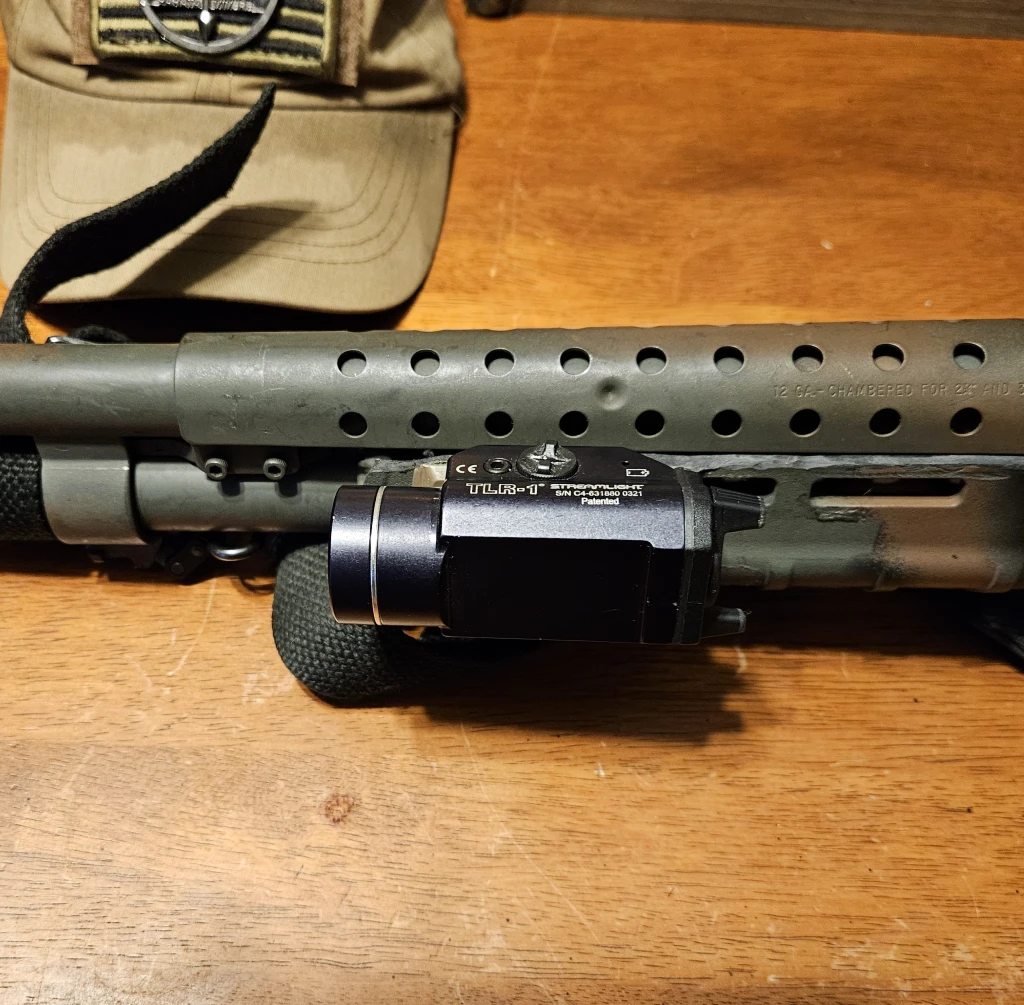
Ammo Carriage
I’ve used everything from a canvas web belt with elastic loops (my first “Combat Equipment Belt”), web or leather bandoleers with elastic loops or leather pouches for rifle ammo, canvas M-1956 buttpacks and M14 mag pouches as well as the LC-2 nylon, M16 mag pouches and the 12 round, “Vietnam Era” LC-1 belt pouches (which have elastic inside the pouch).
From experience, I can tell you that elastic isn’t optimal, and depending on the quality, will generally wear out within 1-15 years. That being said, if it has elastic, but is enclosed in a pouch, it will be useful for a lot longer period of time than something like a belt or bandoleer with exposed ammo retention elastic.
I still use the Vietnam type 12 round pouches in a buttpack to have quick “Grab and Go” ammo carriers, and I separate different types of ammo in the buttpack by the color of the pouch it’s in (Example: OD green has buckshot, black has slugs, camo has birdshot). They have LC-2 ALICE clips on each pouch, and they can easily be pulled out of the buttpack and attached to any type of belt.
For 12GA ammo, the M14 and M16 (30 round mag) rifle mag pouches will hold approximately 25 rounds, but have no way of retaining the ammo, except the top flap of the pouch, and ammo will dump out if you are leaning over or on your side, when you open it. Sewing a cover that has a velcro release on one side would mitigate this issue, to a point, but the rounds could still fall out at an angle.
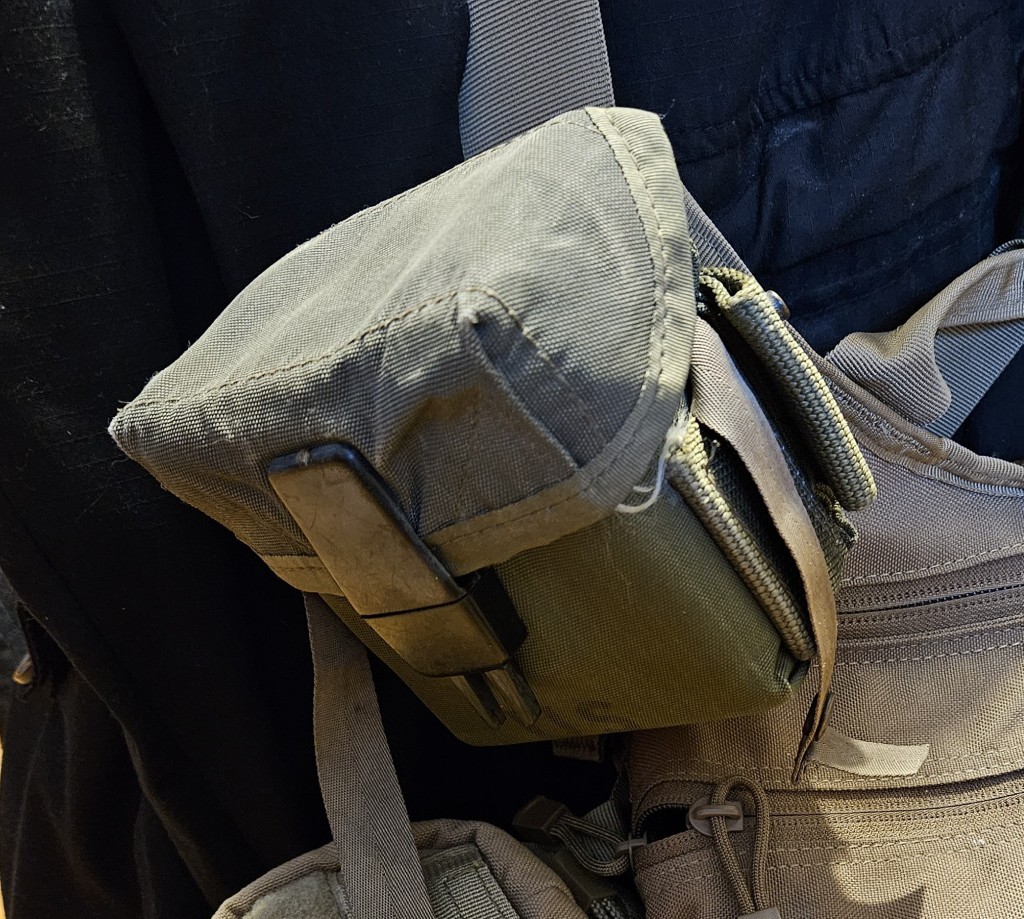
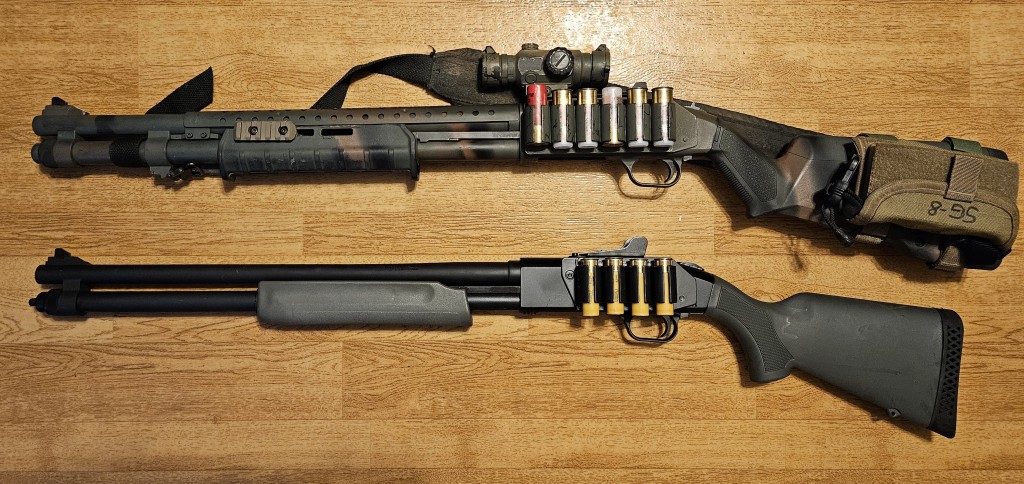
The only exception, I’ve found, to the “Rounds will fall out” rule concerning shotgun ammo in a rifle mag pouch is when I used 20 Gauge shells in a nylon LC-1 20 round mag, M16 pouch. The cardboard box for the shotgun shells actually fit into the mag pouch, and would hold a 20 round box of .223 Remington ammo (Remember, I started with a Savage 24V .223Rem/20GA combo gun) over top of the 20 GA ammo box. These pouches also work great for my Wife’s Mossberg 20GA, 590.
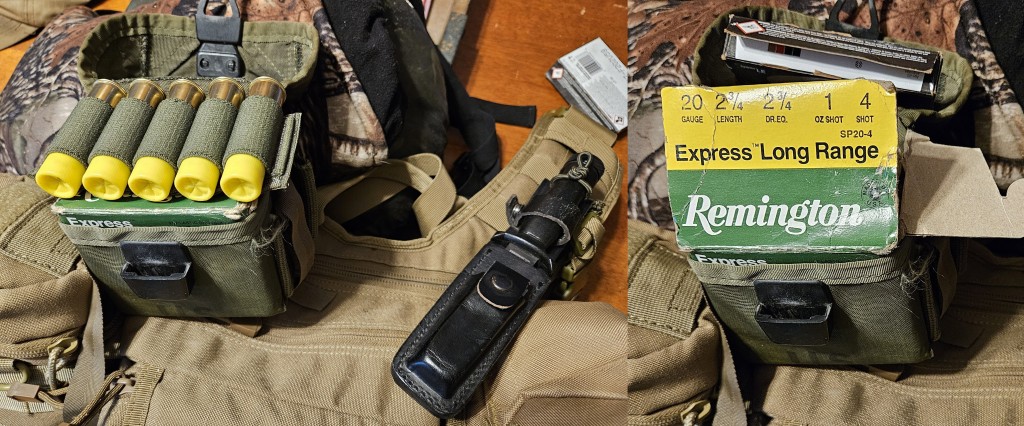

About 10 years ago, I finally settled on the pouches in the pic above. On the left, is a Condor ammo pouch that will hold up to 50 rounds of loose 12 gauge ammo. Unlike the rifle mag pouch idea, mentioned earlier, this pouch retains the ammo by using a removeable semi-elastic cover with a reinforced, pass-thru slit in the center.
In the above pic, the two pouches on the right hold 25 rounds a piece, and have individual elastic loops inside the pouch. Using snaps and velcro, they are designed to open and unfold (see pics in link) as you use the ammo in the pouch.

Loose shotgun ammo is not easily carried, and finding a way to make it easily accessible, but securely retained has been a problem for me since my first shotgun. At that time, it was a canvas M-1956 buttpack on a shoulder strap, A la “Musette Bag”, and the 20 rounds on my belt in individual elastic retention loops. This system gives me up to 100 rounds (I usually only carry 25-30 in the large pouch) of easily accessed 12GA ammo of all types.
Positioning Your Pouches
Just like with a revolver, and positioning your speedloader pouch on the right front, regardless of which hand is “Strongside, “Combat Loading” a pump shotgun is done the same way, whether you are left or right handed. The only difference is where you are holding the shotgun while you load. A right-hander will hold the shotgun forward of the receiver with his left hand , whether the slide is forward or to the rear, and a left-hander will hold it by the pistol grip.
Once the right-handed shooter combat loads the first round into the ejection/loading port, they use their left hand to move the slide forward, closing the action. They then load the magazine through the bottom loading port. A left-hander will load the first round into the ejection/loading port with his right hand, and use that hand to close the action. The left-hander will then continue to load the magazine through the bottom loading port.
Since you are using your right hand to load the shotgun, regardless of whether you are left or right handed, you position the large loose ammo pouch or shell holder on the right side of your vest or load bearing harness.
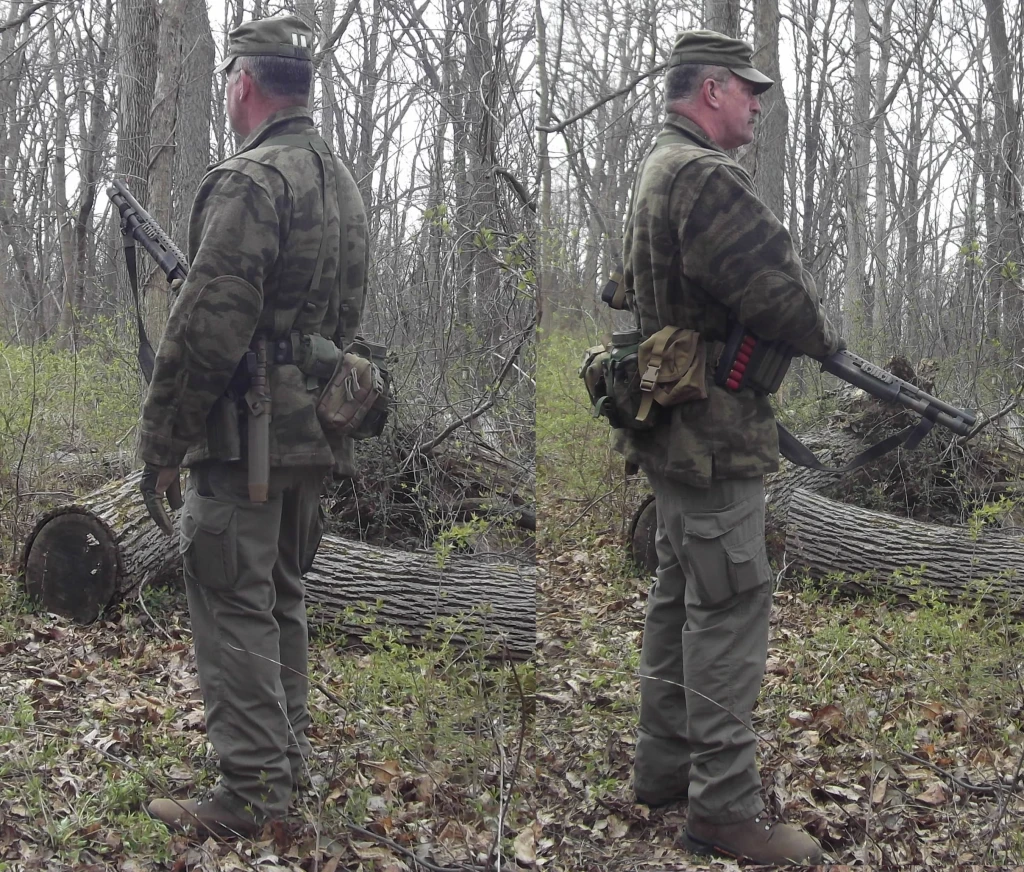
I have and use several of Choate’s “Speed Loader Caddies” to carry 12GA ammo in the quickest access configuration on a belt. On my lightweight “Battle Belt” set up, I carry one loader if I’m wearing a load bearing vest. This goes in place of my single rifle mag carrier, so even if I don’t have my vest on, I have a reload for my shotgun.
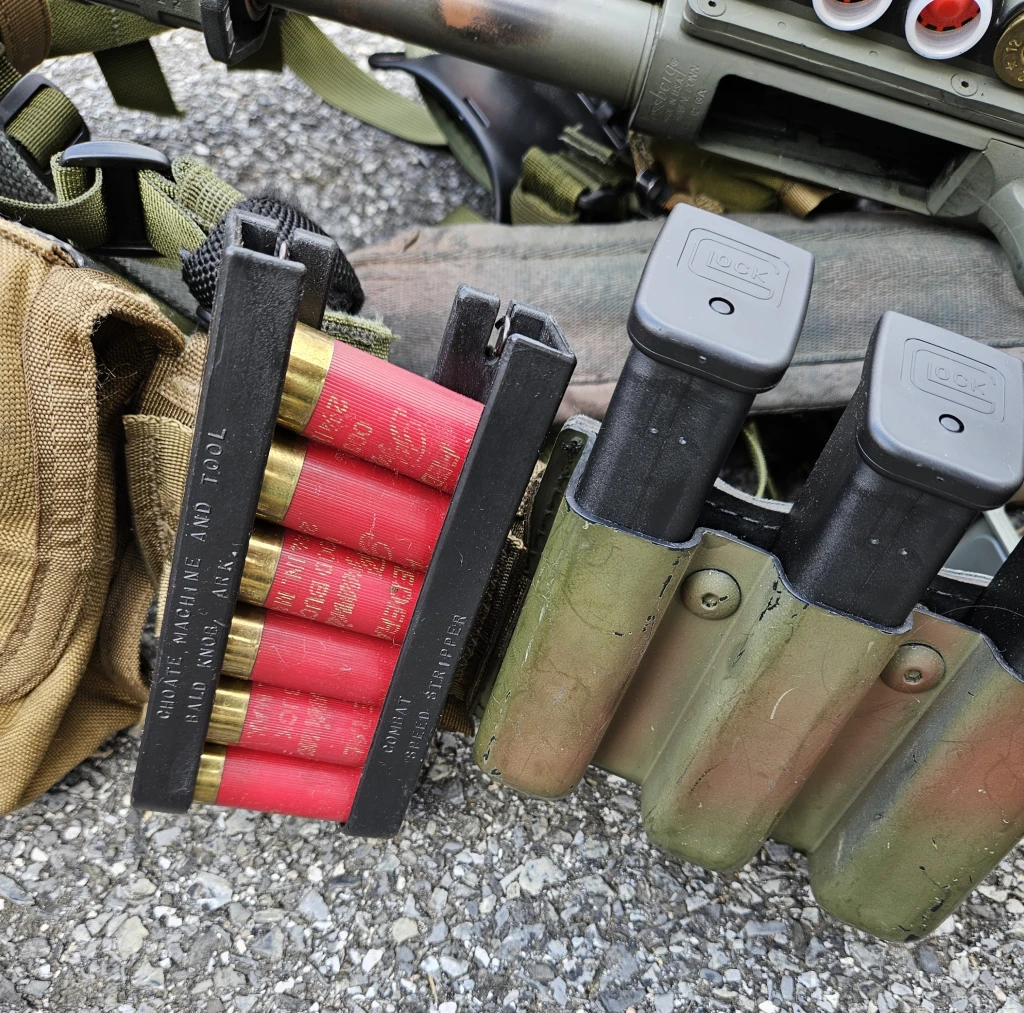
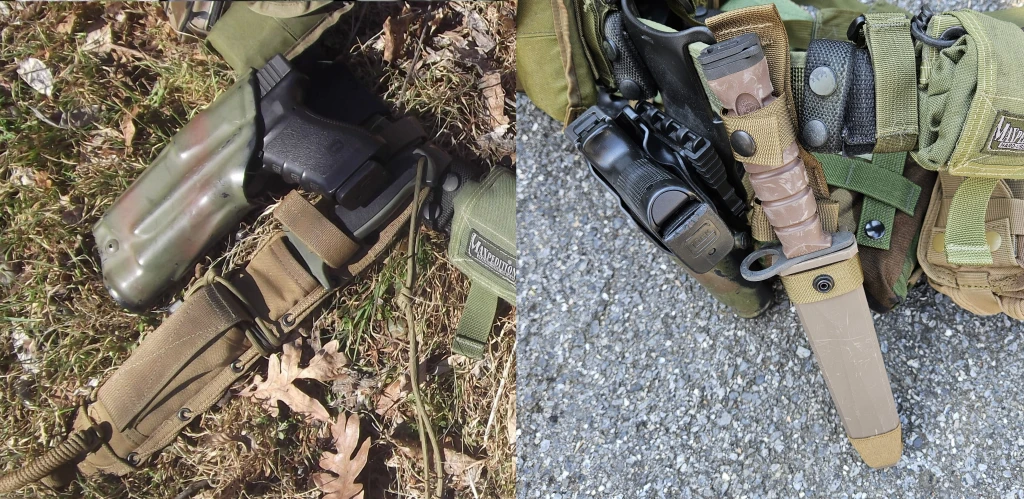
Another addition I made to my Lightweight “Battle Belt”, when I’m carrying my 590, was to replace my 8″ Cold Steel “Survivalist” fixed blade knife, with the 8″ Ontario Knife Company OKC-3S M16 bayonet. As stated earlier, I can’t think of a better weapon, than a repeating pump shotgun, to have a bayonet on, and the 590 has proven to be sturdy enough to handle that kind of stress.
Conclusions
The shotgun has a niche in the world of the Survivalist. It is one of the best long guns to have in a close quarters fight, especially if you don’t want to endanger non combatants two rooms away. The pump shotgun is also the most versatile long gun made, when it comes to being able to load anything in it, even doing it muzzleloader style with black powder.
The shotgun can be loaded up or down in power and projectile to be able to kill anything on the planet, and can even be loaded not to kill, if need be, with non lethal projectiles, and you won’t be using those or the blackpowder loads with your precious 1300. Pistols and rifles don’t even come close to giving you the versatility of a shotgun, and for this reason, the pump shotgun should be considered for your gun rack.
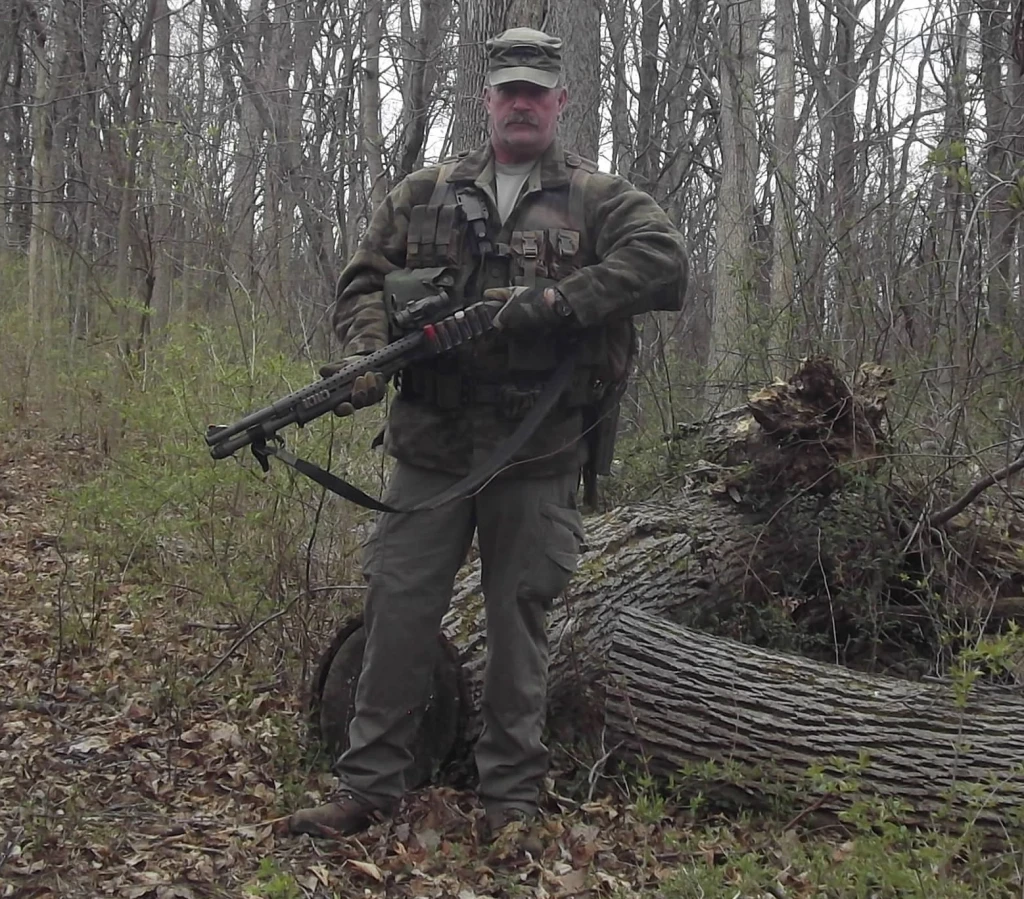
Being able to comfortably, and efficiently carry your ammo for that shotgun is just about as important as the shotgun’s versatility, especially if it is being used in a defensive role. Hopefully, the insights I’ve given you, from my past experience, will help you determine what you need, if you decide to select a shotgun as one of your long guns.
JCD,
The Bushbastard

As an aging boomer, I find the 20 ga is more than capable as ranges become shorter. The 20ga shockwave has few negatives with an XS front site, sidesaddle, and light, is perfection. No complaints with your choices and opinions. You are, as usual, spot on.
LikeLike
Thanks
LikeLike
Totally agree as to the uselessness of a full size PGO shotgun.
LikeLike
I’m a 73-year old woman with Rheumatoid arthritis, and a badly arthritis left wrist (I’m left-handed). Other than pistols, which I’ll be looking at with my sister soon, what rifles/shotguns would be possible to handle with my limitations?
As a kid, I shot a bb gun, and a 22 rifle. That’s pretty much it. I’m willing to put the time in to learn and practice, I just don’t want to depend on a gun that I can’t manage.
FWIW, I live in a small city (Lorain, OH). We’re in a dense part of the city, but only about perhaps 3 miles away from near-rural. IF the city was thinking defensively, our part of town could be safe (just have to raise a drawbridge over the river, and put guards on the bridges that separate us from the projects across the river). My neighbors are stable types, some preppers, some vets, and quite a few dogs for early warning.
I have my comms systems set up (I’m an amateur operator), but, in a pinch, I want to pull my weight in defense.
LikeLike
The Mossberg 505 Bantam #57120 is a five shot .410 pump with the “Bantam” (Youth) length stock, a 20″ barrel. Ambi safety like the ones mentioned in the post, weighs 5.25 pounds, and there are defensive loads available for that chambering. When it comes to pistols and revolvers, with an arthritic strong hand, there are a few choices like the S&W M&P 9mm Shield EZ series, which makes certain gross motor functions, less difficult, strength wise.
There’s always the tried and true four inch .38 Special/.357Magnum revolvers out there, that, in the worst case, you can shoot .38SPC ammo (less recoil, and can be shot through a .357Magnum chambered gun) and cock the hammer (If the double action trigger pull is too hard to pull through, cock the hammer with your weak hand thumb). For rifles, a pistol caliber carbine like Ruger’s PC Carbine in 9mm, would probably be best (you can load the magazines with a mag loader). I’d suggest a pistol caliber lever gun or pump, but loading through the receiver’s side loading gate, would be difficult for you, if you have sever arthritis in your hands, and loading through the tube, like many Henry’s can is very slow.
Hope this helps
LikeLike